The Model Dwellings of Wellington Avenue
by Frank Sharman
At the end of the 19th century, when Wolverhampton council
started to take an interest in the housing of the lower orders, they,
like most local authorities, proved better at knocking down slums than
they were at building anywhere for the workers to live. That
tended to be left to private enterprise and the result was the small
terrace housing of places like Whitmore Reans and Penn Fields. In
the early 1900s this sort of private provision continued, but it was
joined by the garden city movement as well as by council excursions into
council housing. In Wolverhampton the garden city movement was
well represented by the Fallings Park Garden Suburb; and the borough
council built some houses on what was then Green Lane, which later
became the first stretch of the Birmingham New Road.
|
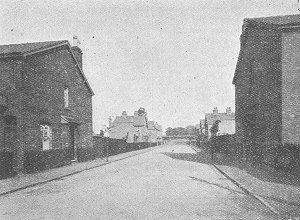 Wellington Avenue, from Church Road, in 1906.
Wellington Avenue, from Church Road, in 1906. |
In 1906, in the Wolverhampton Journal, Wellington
Road in Bradmore was put forward, by the editor, as an example of
provision for the working classes which was far better than the
council had managed and which had at least some of the merits of the
garden suburb.
The editor, though not named in the Journal, was almost
certainly J. P. Jones, an energetic local historian and firm
opponent of almost any local authority expenditure.
In the article in the Journal he attributes the high rents
which the working classes have to pay to the high local
authority rates. |
| This makes it "well-nigh impossible for a working
man to rear a family in a respectable manner and at the same time
'pay his way'". "Working men require well-built houses with
good sanitation and small gardens, at a low rent".
But what had, up to then, been provided, did not suit Jones at
all. Private enterprise had provided "mere hovels - jerry built,
insanitary, tightly crammed rows of houses". |
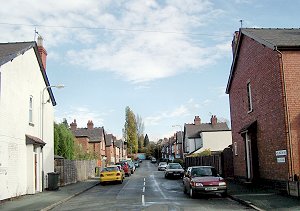
The same view today. |
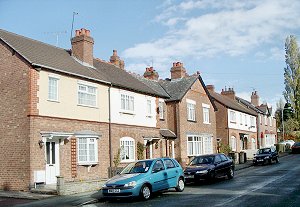
Each pair of semis is different from its
neighbours, but exactly the same as those opposite. |
The council's efforts were as bad. He abuses
the houses in Green Lane for having no front garden, for being
"square, solid, sombre looking buildings, without a vestige of
artistic taste" and says that they "altogether fail to attract the
working men of the town".
He does, however, approve of the garden suburb approach - which had not
quite reached Wolverhampton at that time - and he praises both
Bournville and Letchworth for providing decent homes, at low rents, in
natural surroundings. |
| It was in that context that, "whilst ambling through
Bradmore", he came across Wellington Avenue which was "at once both
pleasing and interesting because in this avenue were erected some
small semi-detached cottages, each pair being of a distinct
character to the other". He does not say who the builders of
this development were but mentions that they were well known in the
locality and that they "had ideas of their own as regards working
men's dwellings". Here Jones seems to be saying that this
estate had been developed as a deliberate reaction to the rows of
terraces and that the builder was trying to produce a better article
in the garden suburb spirit. |
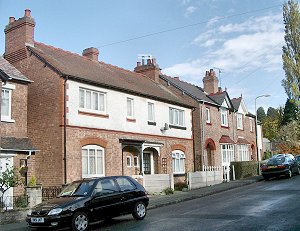
More pairs of semis with
matching opposites. An arrangement which is probably unique in the
City. |
 The first pair going up the Avenue. The
side extension seems to be original.
The first pair going up the Avenue. The
side extension seems to be original. |
Jones waxes lyrical: "The clean well-made
road, lined on each side with trees, the bright harmonising colours
with which the wooden railings, window-frames and doors were
painted, the quaint shapes of the houses, the well-cultivated
gardens, all combined to produce a charming scene".
And the houses had front and back gardens. What is more,
Jones was "more astonished than ever at the small rent asked for
all these advantages". |
| What this rent was, Jones does not say. From
the look of the houses to-day one would certainly say that they were
a great improvement on the terraces - they were bigger and had front
gardens, wider roads, trees in the streets, and even small stained
glass windows in some of the doorways.
One suspects that the working classes who lived here were at
the top end of the working class pay range and would never have
lived in the smaller terrace houses anyway. |
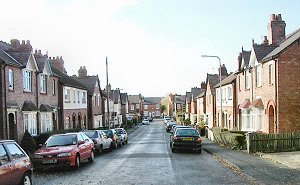
The Avenue (which is a cul de
sac) seen from the top. |
|
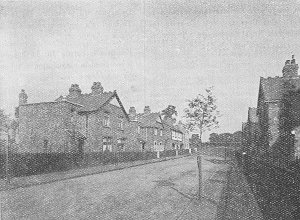
The other photo from the 1906 Journal. |
One also wonders if not only was land cheaper in
Bradmore than it would have been in, say, Penn Fields or Whitmore
Reans, and whether the developer was accepting less of a return on
his investment than he might have got - providing a hidden subsidy.
However that may be the avenue and its houses are still there
today, most of them not greatly altered, and all looking to have
survived well. It would be nice to have the trees back in
the street to make it even more of a garden suburb. |
|

|
|
Return to
Interesting Buildings |
|
 Wellington Avenue, from Church Road, in 1906.
Wellington Avenue, from Church Road, in 1906.


 The first pair going up the Avenue. The
side extension seems to be original.
The first pair going up the Avenue. The
side extension seems to be original.

